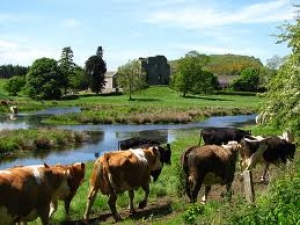Feeds for dairy cows
Feeding Alternatives When Hay Supplies

When thinking about alternative feeds, a producer needs to evaluate storage facilities, feeding facilities and methods of handling feeds not normally fed on the farm. Even though some alternative feeds may be available in your area, they may be impractical if you have no way to handle, feed or store them. Sometimes the cost of getting prepared to utilize a particular feed is simply prohibitive. In these situations it may come down to reducing animal numbers to match available feed supplies.
Most producers will think of corn first, but increased corn prices may make this feed less appealing than in previous years. As a general rule-of-thumb, it takes 5 pounds of corn to replace 9 pounds of average quality hay. Corn should not be used to replace more than 50 percent of the forage in most cow-calf rations. When utilizing corn to stretch forage, you should not forget other nutrients such as protein. Remember that corn does not have to be cracked or ground, but feeding corn does require adequate bunk space so all cattle have equal access. Bunks do not need to be elaborate, but there must be enough space to prevent “boss” cows from eating too much and younger and less assertive cows from being blocked from eating any supplemental corn.
Other grains may also be possible substitutes for hay. Grains such as milo, oats, barley or wheat may be used in cow-calf rations. Each of these grains will require some processing before feeding. Be sure to include the cost of processing in the total cost of the feed.
Another option for stretching available hay is feeding by-product or co-product feeds. These feeds are produced as a secondary product during the production of other products. Included in this list are distiller’s byproducts, whey, corn gluten feed, vegetable byproducts or food processing byproducts. Regardless of which by-product is being considered, several factors must be weighed before it is used. First is the moisture content. Many by-product feeds are high in moisture, which makes transportation expensive and may make them unstable for storage. Always calculate the value of feeds on a dry-matter basis. For example, if a feed is 40 percent dry matter, divide the price paid by 0.4 to figure the value on a dry matter basis. Also, calculate transportation costs. The true cost of feed includes all transportation costs and should be calculated on the value as delivered to the farm.
Always check the nutrient content of by-product feeds. If an analysis is not available, send a sample to a laboratory. A problem with many by-product feeds is that they are often variable in nutrient content. This makes formulating a balanced ration very difficult, if not impossible. Be alert to any contaminants that may be in the feed. These could include any chemical or waste products added or formed during the production process that may be detrimental to animal performance or health. An example of this would be sulfur in corn gluten feed. Typical sulfur levels in gluten feed are 0.4 percent, but levels in the 0.6 percent range may cause problems.
Do not forget crop residues. These may be very low in quality by the time they are used during January or February; however, they will have some feed value and can be used if properly supplemented. Typical supplements would need to be high in protein and have a good mineral balance.
Whole cottonseed may be an option in some areas. The seed provides both energy and protein, but needs to be limited to 3 to 4 pound per head per day for stocker calves and 4 to 5 pounds per head per day for cows. Feeding higher levels (or free-choice) may cause scours due to the high fat (oil) content of the seed. Do not feed whole cottonseed to young growing bulls.
As you consider stretching your available hay supply, do not forget commercial supplements. Just be sure to select the proper supplement for your situation. Some supplements are primarily a source of protein. These may be used to balance the ration for protein but are not the preferred product to stretch hay supplies. Rather, feeds that contain energy are the primary ones to consider. When considering commercial supplements, make a careful comparison of available supplements. Be sure they provide what is needed and that the cost is kept as low as possible. This does not mean that junk feeds should be purchased but, the highest priced feeds may not be warranted either. Don’t forget to consider the convenience cost. Some feeds that require less effort to feed may significantly increase winter feed costs.
Getting through the winter may be difficult with a limited hay supply; however, it can be done if you look closely at available feed resources that can be substituted for hay. The key is to select the most economical feeds that will meet the animals’ needs.
























